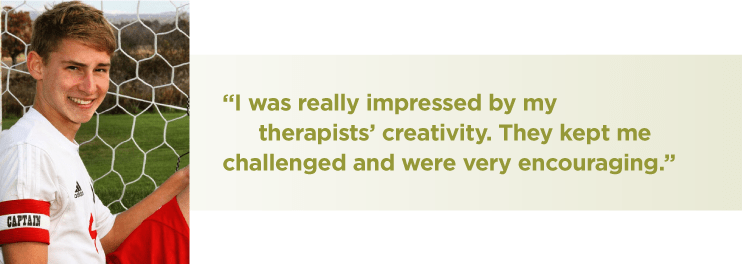The Challenge: A Pounding Headache and Nausea
As a college freshman majoring in computer science, Ross, 18, ascribed his pounding headache and excessive nausea to a common stomach virus. He visited his school’s student health office the next day and they advised him to rest.
Two days later, the pain in Ross' head had become unbearable and he:
- Had lost most of his balance.
- Wasn’t able to walk.
- Had numbness of the face.
Ross didn’t want to miss another day of class but his mother, fearing he had meningitis, insisted he see a doctor. She took him to UPMC Jameson.
A CT scan revealed a brain bleed called a cavernous malformation, which is a microscopic cluster of abnormal, dilated blood vessels.
The Path to UPMC to Confirm His Cavernous Malformation Diagnosis
Ross flew by medical helicopter to UPMC Presbyterian where an MRI and an angiogram confirmed his diagnosis. Thankfully, there was no aneurysm and the bleeding had stopped.
Located on Ross’ brainstem, the malformation caused stroke-like symptoms, including:
- Loss of balance.
- Disturbed vision.
- Facial numbness.
Due to its tricky location, surgeons can't remove it. It's something Ross will have to live with the rest of his life.
The Solution: Inpatient Rehab to Speed Healing
After four days at Presby, Ross moved to the UPMC Rehabilitation Institute at UPMC Passavant.
He took part in physical, occupational, and speech therapy.
Ross recalls:
“My condition was frustrating but I just got up each day and did what I had to do. I didn’t dwell on whether or not I’d get better. There was no point in being upset about my situation. I just had to get better.”
Ross took that mindset with him to therapy each day and made great progress.
His physical therapist, Amanda, had him stand on a foam pad with his eyes closed to improve his balance.
Danielle, Ross' occupational therapist, created a scavenger hunt throughout UPMC Passavant. She asked him to find places such as the gift shop, chapel, and cafeteria. This helped him improve his balance and walking.
Danielle would also set up cones with plastic squares and coins on top of them. Ross had to use clothespins to pick up the coins, which improved his concentration and agility.
During speech therapy, Ross would read out loud and exaggerate pronouncing the words, which helped both his speech and eyesight.
“I was really impressed by my therapists’ creativity,” says Ross. “They kept me challenged and were very encouraging. The therapy definitely helped speed up my healing process so I could get better faster.”
The Results: Ross Gets His Life Back
Ross' rehab programs helped him regain his activities of daily living, such as:
- Walking.
- Keeping his balance.
- Getting dressed.
- Bathing.
- Speaking clearly.
- Dealing with numbness of the face and mouth.
After a three-week stay at the UPMC Rehabilitation Institute, Ross went home without assistive walking devices.
He will keep doing outpatient physical therapy.
And, he plans to start his spring semester of classes in January — less than three months after his diagnosis.
Learn more about inpatient rehab
To find out more about our services, contact the UPMC Rehabilitation Institute.
Or, visit the UPMC HealthBeat blog to read:
- What to Pack for Inpatient Rehabilitation
- What Is Occupational Therapy?
- Not Just For Kids: How Speech Therapy Helps Adults
This patient's treatment and results may not be representative of all similar cases.

















